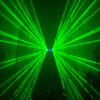New Laser-activated Dye Kills Bacteria
Source: Dailytech
Bacterial resistance to treatments may become a thing of the past thanks to a little green dye and low power lasers.
Bacteria can be a big problem. Bacterial infections kill many thousands of people each year, even in hospitals where care can be given. Some of these infections come from those very hospitals, in fact.
A growing problem is that bacteria, like most organisms, evolve to combat things that are dangerous to them. This has produced strains of bacteria that no longer respond to treatments that once hindered their growth. While advances such as MIT’s bacteria resistant polymer will surely help prevent hospital-caused infection, it does not help treat them once they’ve taken root, nor can it do much against infections caused from accidents in less clean environments.
That’s where lasers come in to diffuse the situation. While the statement conjures up visions similar to Johns Hopkins’s virus busting laser, raining beams of bacterial genocide down upon an infection, it’s a lot less difficult than that. In fact, the laser in this case doesn’t even need to make contact with the bacteria to do the job. Instead, a harmless dye known as indocyanine green is what brings a quick end to the harmful invaders. Or more specifically, what happens to the dye when it’s activated by a near-infrared laser.
The effect is similar to Rensselaer Polytechnic Institute’s cancer killing nanoparticle treatment. When a laser, in this case a 500mW gallium-aluminum-arsenide near-infrared laser projecting at 808nm wavelength, is shined at a photosensitizer, the indocyanine green, it creates free radicals known as reactive oxygen species. These free radicals destroy bacteria by disrupting numerous parts of their physiology.


Recent Comments